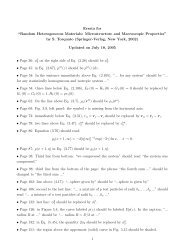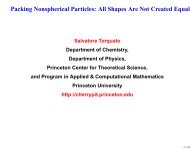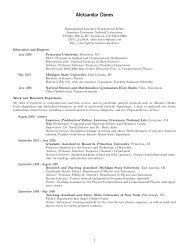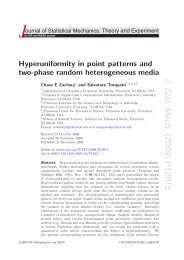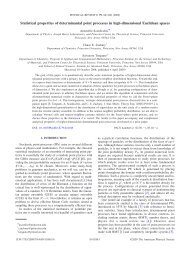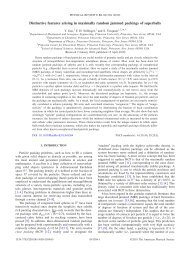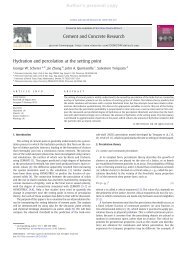Families of tessellations of space by elementary polyhedra via ...
Families of tessellations of space by elementary polyhedra via ...
Families of tessellations of space by elementary polyhedra via ...
You also want an ePaper? Increase the reach of your titles
YUMPU automatically turns print PDFs into web optimized ePapers that Google loves.
RUGGERO GABBRIELLI, YANG JIAO, AND SALVATORE TORQUATO PHYSICAL REVIEW E 86, 041141 (2012)<br />
FIG. 8. (Color online) Dissected view <strong>of</strong> the DO tiling [23] with<br />
side ratio 1/3. This is associated with the conjectured densest known<br />
packing <strong>of</strong> octahedra [25], which is a lattice packing [24]. The image<br />
shows the net <strong>of</strong> vertex-sharing tetrahedra filling the gaps <strong>of</strong> the<br />
packing <strong>by</strong> octahedra.<br />
Tilings <strong>of</strong> R 3 <strong>by</strong> congruent octahedra and small tetrahedra<br />
with different sizes are shown in Fig. 9. These tilings are<br />
rational approximants <strong>of</strong> intermediate configurations during<br />
the continuous transformations that bring, respectively, LO and<br />
DO tilings to the FCC tiling. The edge length <strong>of</strong> the tetrahedra<br />
compared to the edge length <strong>of</strong> the octahedra are, respectively,<br />
1/3 and 2/3 for the tiling shown in the left panel <strong>of</strong> Fig. 9,<br />
and 1/2, 1/3, and 1/6 for the tiling shown in the right panel<br />
<strong>of</strong> Fig. 9.<br />
B. Tilings associated with tetrahedron packings<br />
<strong>via</strong> re<strong>tessellations</strong> <strong>of</strong> the FCC tiling<br />
In the UT tiling (i.e., the tiling associated with the uniform<br />
packing <strong>of</strong> tetrahedra), each tetrahedron tile is associated with<br />
one octahedron tile whose side length is 1/2 <strong>of</strong> that <strong>of</strong> the<br />
tetrahedron with centers lying on a primitive tetragonal lattice<br />
[19]. The fundamental repeat unit <strong>of</strong> this tiling contains two<br />
FIG. 9. (Color online) Rational approximants <strong>of</strong> intermediate<br />
configurations during the continuous transformations that bring,<br />
respectively, the LO and DO tilings into the FCC tiling. The two<br />
tetrahedral holes <strong>of</strong> different size are visible in the LO tiling. The<br />
three types <strong>of</strong> tetrahedra have been added to the DO configuration<br />
for clarity. Note how each intermediate configuration, although now<br />
composed <strong>of</strong> more than two kinds <strong>of</strong> tile (voids are not identical), can<br />
still be retessellated as an FCC tiling. Animations showing the relative<br />
motion <strong>of</strong> the octahedra in the tiling can be viewed online [31,32].<br />
041141-8<br />
FIG. 10. (Color online) Dissected view <strong>of</strong> the UT tiling. The<br />
gaps in the uniform packing <strong>by</strong> tetrahedra described in Ref. [19]<br />
are regular octahedra <strong>of</strong> side 1/2, whose centers lie on a primitive<br />
tetragonal lattice. Note that each larger regular tetrahedron can be<br />
dissected into five smaller units, as shown in Fig. 1,leadingtotheFCC<br />
tiling. The repeating unit contains two tetrahedra and two octahedra<br />
(tile ratio is 1).<br />
tetrahedra and two octahedra (with tile ratio t = 1). Note that<br />
each large tetrahedron tile can be dissected into five smaller<br />
tiles (one octahedron and four tetrahedra), as shown in Fig. 1.<br />
Together with the small octahedra, the tiles associated with the<br />
dissected tetrahedra lead to the FCC tiling (see Fig. 10).<br />
A tiling <strong>of</strong> R 3 <strong>by</strong> large tetrahedra and small noncongruent<br />
octahedra obtained <strong>via</strong> retessellation is shown in Fig. 11. The<br />
side lengths <strong>of</strong> the small octahedra are, respectively, 1/3 and<br />
2/3 <strong>of</strong> that <strong>of</strong> the tetrahedra. This tiling is a member <strong>of</strong> the<br />
family described in Sec. III B, with the parameter α = 1/3.<br />
Together with the smallest octahedra, the tiles associated with<br />
the dissected tetrahedra and the intermediate octahedra lead to<br />
the FCC tiling.<br />
C. Tilings <strong>by</strong> truncated tetrahedra and tetrahedra<br />
<strong>via</strong> retessellation <strong>of</strong> the FCC tiling<br />
It has recently been shown that Archimedean truncated<br />
tetrahedra can pack to the extremely high density <strong>of</strong> φ =<br />
207/208 = 0.958333 ...[34]. It was shown that this packing<br />
can be achieved <strong>by</strong> a continuous deformation <strong>of</strong> the packing <strong>of</strong><br />
truncated tetrahedra discovered <strong>by</strong> Conway and Torquato [19]<br />
FIG. 11. (Color online) A rational approximant <strong>of</strong> an intermediate<br />
configuration during the continuous transformation that brings UT<br />
into FCC. Each intermediate configuration can still be retessellated<br />
as an FCC tiling. An animation showing the relative motion <strong>of</strong> the<br />
tetrahedra can be viewed online [33].



